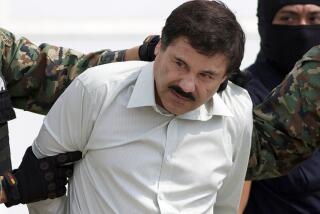U.S. Names Alleged Leader of Drug Cartel
- Share via
EL PASO — Federal authorities, making public a 27-count indictment, Wednesday identified Vicente Carrillo-Fuentes, brother of a Ciudad Juarez-area drug lord who died after plastic surgery in 1997, as the bloodily contested cartel’s new leader.
Although a federal grand jury had returned the sealed indictment in August 1997 and requested the extradition from Mexico in November, authorities only unsealed the documents this week. Some officials said they decided to publicize the indictment--which lists seizures of 3,757 kilograms of cocaine and 9,395 pounds of marijuana over a 12-year period--partly to increase pressure on Mexico to snare Carrillo-Fuentes and deliver him to the United States.
Saying Mexican officials have “tried to be cooperative,” U.S. Atty. Bill Blagg acknowledged that Mexico has rarely extradited alleged drug traffickers.
Robert Castillo, special agent with the federal Drug Enforcement Administration, said: “I think the only reason [to announce the indictment] is to probably put a little bit more pressure on the Mexican government. . . . We’ve got to do something.”
Along with the Tijuana-based cartel, the Juarez operation is believed to be one of Mexico’s two largest drug organizations. Ciudad Juarez is across the Rio Grande from El Paso.
Carrillo-Fuentes’ indictment includes federal drug and money laundering charges and seeks $56.5 million in criminal asset forfeiture. The figure is based on the alleged drug merchant’s anticipated earnings on tons of cocaine and marijuana seized by authorities. In addition to millions of dollars in fines, Carrillo-Fuentes faces up to life in prison if he is convicted.
Believed to be somewhere in Mexico, Carrillos-Fuentes was responsible for funneling cocaine and marijuana through the western area of Texas en route to cities including Dallas, Chicago and New York, law enforcement agents said.
His brother, Amado Carrillo-Fuentes, was legendary for his abilities to bully or coax Colombian drug traffickers into working with him. After Amado’s July 4, 1997, death, linked to plastic surgery undertaken to hide his identity, the Juarez-El Paso drug organization fell into violent disarray.
Vicente Carrillo-Fuentes apparently assumed the cartel’s leadership after a rival, Rafael Munoz-Talavera, was killed this year, agents said.
Nevertheless, gory contests for cartel dominance still make Juarez unsafe even for uninvolved residents who may get caught in cross-fires, the DEA’s Castillo said.
More to Read
Sign up for Essential California
The most important California stories and recommendations in your inbox every morning.
You may occasionally receive promotional content from the Los Angeles Times.










